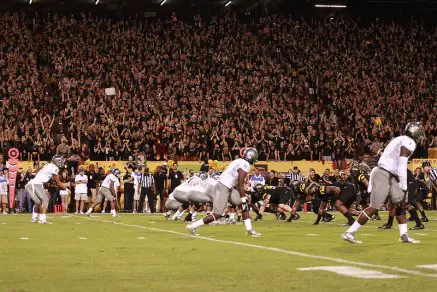 Well, Duck fans, we’re smack dab in the middle of the bittersweet period known I like to call the “Bowldrums.” Sure, we’ve got a great matchup ahead of us, but as Tom Petty once said, “The waiting is the hardest part.” So here we are: waiting for January 3. What are our coaches and players doing? In short: studying film. A LOT of film. Now, as fans, we always hear about film: “We need to get back and look at the tape;” or “He spent the entire off-season in the film room;” or “This guy is just a film room junkie;” or “Coach Kelly must have seen something on film;” or “He’s going to really hear about that in the film room tomorrow.” But – what does that actually MEAN? What do our players and coaches DO in the film room? How do we scout opponents? What are the things that our coaches and players are looking for as they look at Kansas State on film? DISCLAIMER: This is but one fan/former small-time college player/former small-time coach’s personal experience of looking at and breaking down film. No guarantee this is THE way to do it, and even less of a guarantee that this is the way the DUCKS do it. But hopefully this will enlighten the “next-level” fan on what generally goes in inside the mysterious place called the “film room.”
Well, Duck fans, we’re smack dab in the middle of the bittersweet period known I like to call the “Bowldrums.” Sure, we’ve got a great matchup ahead of us, but as Tom Petty once said, “The waiting is the hardest part.” So here we are: waiting for January 3. What are our coaches and players doing? In short: studying film. A LOT of film. Now, as fans, we always hear about film: “We need to get back and look at the tape;” or “He spent the entire off-season in the film room;” or “This guy is just a film room junkie;” or “Coach Kelly must have seen something on film;” or “He’s going to really hear about that in the film room tomorrow.” But – what does that actually MEAN? What do our players and coaches DO in the film room? How do we scout opponents? What are the things that our coaches and players are looking for as they look at Kansas State on film? DISCLAIMER: This is but one fan/former small-time college player/former small-time coach’s personal experience of looking at and breaking down film. No guarantee this is THE way to do it, and even less of a guarantee that this is the way the DUCKS do it. But hopefully this will enlighten the “next-level” fan on what generally goes in inside the mysterious place called the “film room.”
I. THE D.O.S. QUESTION
First and foremost, we’ve gotta answer the D.O.S. Question: Are we looking at Defense, Offense, or Special Teams? If we are only casually reviewing film (or looking at specific types of plays like we do at FishDuck), it’s not a big deal to do this. But just like everything else these days, film review has gone high-tech and digital. There are computer programs that categorize film based on a thousand and one different factors as input by film reviewers, as I’ll explain more below. Thus, you’ve gotta answer the D.O.S. Question first to make sure the particular play you’re looking at goes in the right category! As of this writing, FishDuck has not yet thoroughly analyzed Oregon’s Special Teams. Though special teams deserve large-scale analysis in its own right, the FishDuck coaching staff hasn’t yet dived in. So, we’ll look at the two primary phases of the game: defense and offense.
II. SCOUTING THE OFFENSE
Step One: Break Down Each Offensive Play
Coaches (or, more likely, graduate assistants) look closely at EACH AND EVERY PLAY they see from opponents. And here’s 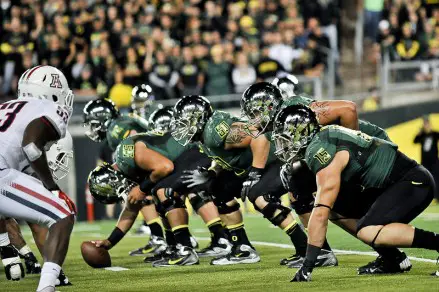 (generally) what they look for:
(generally) what they look for:
a. Down and Distance. Is it 1st and 10? 2nd and short? 3rd and long? 1st and 15? Mark it down.
b. Offensive Personnel. Who’s on the field? How many TE’s? How many RBs? WRs? Shotgun? Under center?
c. Offensive Formation. Where do their guys line up? Where’s the TE? Where are the RBs? How deep are they? How many WRs to each side? Is the offensive line in an unbalanced set?
d. Offensive Shifts & Motion. Do their players change alignment before the snap? Do they shift (move to a new spot and get re-set) or go in motion (start moving and keep moving at the snap)? Where do they start? Where do they finish? Do any of these shifts or motions cause the offensive strength to change?
e. Audibles. Does the QB audible to a new play? Who does he speak to? Just the OL, or the entire team? Can we tell if it changed only pass protection, or the entire play? Does he identify who the option read men are? Can we tell what the QB saw from the defense that caused him to audible?
f. Snap Count. Can we tell what the snap count is? On one? On two?
g. Run Blocking Scheme. Who blocks whom? Any double teams? Does any lineman pull? Who do the RBs and WRs block? Zone blocking or man-on-man blocking?
h. Path of RB. Where does the RB go on a run play? What are his keys? Is he trying to go through a certain “hole,” or is he reading zone blocking?
i. Pass Blocking Scheme. Who blocks whom? Is it zone pass protection, or man? On blitzes, who is responsible for each blitzer, and where does the blitzer come from?
j. Receiver Routes. On pass plays, what routes do each of the receivers run? Are they set, or do they have options depending on what coverage they see?
k. QB Pass Reads. What does the QB see? What is his progression (i.e. his 1st, 2nd, 3rd options)? Can we tell what coverage he sees? Where is his throw? Can we tell why he decided to throw to a particular option? Can he scramble? When does he like to scramble? Where does he like to scramble?
l. Special Questions for Option Teams. If the offense runs an option play, who are the option read defenders? Who are the offensive options (i.e. dive, QB, pitch)? Does the QB tend to prefer one option over another? Where do the pitch men come from?
m. Diagram the Play. Write down the exact play that is run. Where does everyone go?
n. Note Special Features. Are there any fakes that are carried out? Does this play ALWAYS have a certain player go in motion? 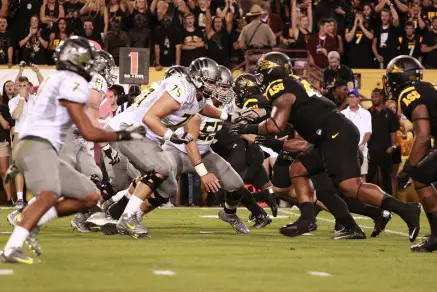 Does a play always go to the strong side? Always to the wide side of the field?
Does a play always go to the strong side? Always to the wide side of the field?
Step Two: Identify Offensive Tendencies
a. Formation Tendencies. What are their formations and personnel packages? Does the offense tend to run certain plays out of certain formations? Does the offense generally use certain formations on certain downs and distances? Do they align their TE in unique ways? Do they ever use an unbalanced line? Do they change their formation due to the wide-side or narrow-side of the field? How often do they go in motion or shift?
b. Scheme Tendencies. What are their go-to plays? Do they run certain plays on their own side of the field/in the middle of the field/in the red zone? Do they use certain plays against certain defenses? What are they trying to target on the defense? Do they run option often? Which direction? Do they like to pass on certain downs and distances? What does the offense like to do on 3rd and short or on the goal line? What do they like to do on 4th down? What do they do in the 2-minute drill? Do they call plays differently depending on whether they’re ahead or behind, or by how much time is left in the game? (Note: There are about a million questions that can be asked here: the really great defensive coaches just have a “feel” for the offense’s tendencies.)
c. Player Tendencies. Who are their go-to guys? Where do they align? How often do they get put in motion? What do each of their players do well? What do they not do well? What kind of blitzes do linemen struggle to recognize? What kind of pass rush moves do linemen struggle against? Are the WRs and RBs good blockers? Do certain coverages rattle QBs? What makes the QB make bad decisions? How does the QB do against the blitz? Who’s the weakest link on the offensive line? Who has trouble with ball security?
Step Three: Anything Weird?
This is an important, but often overlooked, part of scouting. Does the offense do anything that’s just sort of…wacky? Trick plays? 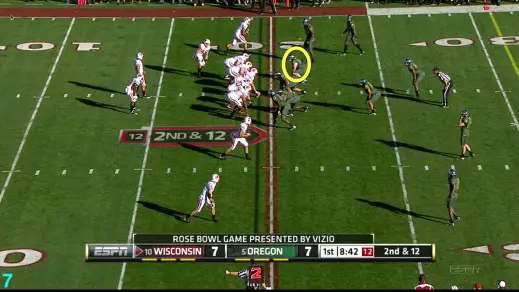 Weird formations? Will they unexpectedly go for two after TDs?
Weird formations? Will they unexpectedly go for two after TDs?
As an example (and not to bring up old high school war stories but to bring up high school war stories): As a high school player, we were traveling to Northern Idaho to play in a state quarterfinal playoff game against a team we had no familiarity with. They did something very odd. On most special teams plays, and on certain offensive plays, their linemen would stay in a 2-point stance. The QB would bark a signal, and the entire line would do a strange “shift:” they would all spring both their hands up into a “double guns” pose, hold it, and then snap the ball on the next count. Now, this little wrinkle didn’t actually ACCOMPLISH anything Xs and Os-wise, but man did it work in drawing defenses offsides! We had to be prepared for this little oddity so that we wouldn’t turn a 3rd or 4th and 4 into 1st and 10 for no reason!
Step Four: Teach the Players and Draft the Defensive Game Plan
Once we’ve gathered the intel, we’ve gotta condense it into a readable format to give to the players. They need to know the same Xs and Os and tendency information that we’ve gathered from film. The secondary needs to know what pass plays are run, and what routes they’ll face. The DL needs to know the run blocking and pass blocking schemes, and who are the weak links in the OL. The LBs need to know all the run plays, and recognize the path of the ball carrier. The whole team needs to know if the offense runs any option, and which players are more likely to fumble. And, of course, the team needs to know what plays to expect in certain game situations.
The coaches need to look at all this information, too, and draft a defensive game plan that accounts for the strengths of the offense, and exploits the offense’s weaknesses. Easier said than done!
III. SCOUTING THE DEFENSE
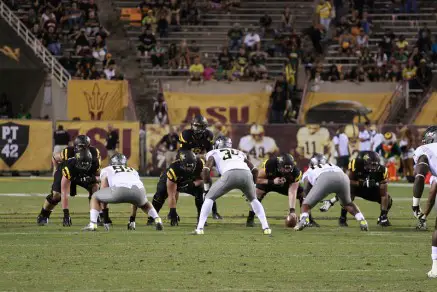 Step One: Break Down Each Defensive Play Again, coaches look closely at EACH AND EVERY PLAY they see from opponents, and generally look for the following: a. Down and Distance. Mark it down. b. Offensive Personnel. Who’s on the field for the offense? How many TE’s? How many RBs? WRs? Shotgun? Under center? c. Defensive Personnel. And, in response to the offensive personnel, who’s on the field for the defense? How many defensive linemen? DEs? LBs? Corners? Safeties? And which numbers are in which spot? d. Defensive Alignment. Where are all the defensive guys? Odd number of defensive linemen, or even? Is there a nose guard? Where are the LBs lined up? How deep are they? Where are the corners? Are they heads up on the WRs? Are they in soft coverage? Where are the safeties? e. First Look. Take note of where each defender is aligned when they break the huddle. f. Pre-Snap Look. Did anyone move? Did the DLs, LBs, or DBs change alignment leading up to the snap? g. Audibles. Do changes in alignment come as a result of a defender yelling out an audible? Which player is tasked with doing so? Does more than one player call out audibles? What offensive formation or motion causes the audible? h. At-the-Snap Look. Where do the DL, LBs, DBs move at the snap? Do they drop into coverage? Do they blitz or stunt? Who goes where? And if there’s a blitz or stunt, what coverage is behind it? i. Coverage. What are the coverage responsibilities of the LBs and DBs? Man? Zone? Mixed coverage? Who has the TE? Do they show one coverage pre-snap, and move into another at-the-snap?
Step One: Break Down Each Defensive Play Again, coaches look closely at EACH AND EVERY PLAY they see from opponents, and generally look for the following: a. Down and Distance. Mark it down. b. Offensive Personnel. Who’s on the field for the offense? How many TE’s? How many RBs? WRs? Shotgun? Under center? c. Defensive Personnel. And, in response to the offensive personnel, who’s on the field for the defense? How many defensive linemen? DEs? LBs? Corners? Safeties? And which numbers are in which spot? d. Defensive Alignment. Where are all the defensive guys? Odd number of defensive linemen, or even? Is there a nose guard? Where are the LBs lined up? How deep are they? Where are the corners? Are they heads up on the WRs? Are they in soft coverage? Where are the safeties? e. First Look. Take note of where each defender is aligned when they break the huddle. f. Pre-Snap Look. Did anyone move? Did the DLs, LBs, or DBs change alignment leading up to the snap? g. Audibles. Do changes in alignment come as a result of a defender yelling out an audible? Which player is tasked with doing so? Does more than one player call out audibles? What offensive formation or motion causes the audible? h. At-the-Snap Look. Where do the DL, LBs, DBs move at the snap? Do they drop into coverage? Do they blitz or stunt? Who goes where? And if there’s a blitz or stunt, what coverage is behind it? i. Coverage. What are the coverage responsibilities of the LBs and DBs? Man? Zone? Mixed coverage? Who has the TE? Do they show one coverage pre-snap, and move into another at-the-snap?
Step Three: Identify Defensive Tendencies Once we’ve figured out what defenses do on an Xs and Os basis, now we look at more philosophical factors: What are a defensive team’s tendencies? a. Alignment Tendencies. Do defenders align themselves according to the offense’s “strong side?” According to TE position? According to the ball’s position on either hashmark? Does a certain defender follow a certain offensive player, i.e., is a specific CB always on the #1 WR? A specific DE always matched up on a certain OT, or on the QB’s “blind side?” Is a certain linebacker always over the TE? b. Scheme Tendencies. Does the defensive coordinator tend to blitz on a certain down? Tend to slant DL to the strong side? To the wide side of the field? Play more zone? More man? Do coverages vary if the team is ahead or behind? How well do defenders cover the sidelines in 2-minute drill situations? How do they defend the option? c. Player Tendencies. Figure out the defensive two-deep, and look at each of the strengths and weaknesses of specific defenders. Does a certain DT do a poor job against double teams? Does a certain linebacker struggle  covering RBs on pass plays? Will a certain CB bite on pump fakes? Does the FS have trouble defending throws to the sideline? Who are the best tacklers? The worst? Do players have “go-to” pass rush moves or ways to shed run blocks? Do certain players have trouble recognizing the option?
covering RBs on pass plays? Will a certain CB bite on pump fakes? Does the FS have trouble defending throws to the sideline? Who are the best tacklers? The worst? Do players have “go-to” pass rush moves or ways to shed run blocks? Do certain players have trouble recognizing the option?
Step Three: Anything Weird? We talked about this question under the offense section above, so again we look at whether there is anythin strange or wacky that the defense does that the players need to be prepared for.
Step Four: Teach the Players and Draft the Game Plan Again, we’ve gotta condense all our intel on Xs and Os and tendencies into a readable format to give to the players. Offensive linemen need to know what the DL are likely to do against certain run plays, and who the good pass rushers are. Quarterbacks need to know how the secondary disguises their coverages. RBs need to know how the defense will defend the option, or which players are responsible for covering them in the pass game. And the whole team need to know about the tendencies of the defensive scheme.
And again, the coaches need to analyze all of this information, then draft an offensive game plan that avoids and accounts for the strengths of the defense, and exploits the weaknesses. The great coaches do it better, of course, and like Mike Tyson once said: “Everybody has a plan until they get punched in the face.” The pre-game coaching is helpful, but the in-game coaching is crucial to adapt to what the defense is doing, and having success with. — As you can see, the world of film scouting is no easy feat! It’s a little different than the way you or I watch a football game. But this part of coaching is crucial to a team’s success.
The better-prepared a team is, the more likely they’ll respond better during the game to the opponents’ strategies, and not get fooled by the tricky things that another team does. Keep in mind, as I mentioned earlier, college coaches now have incredible technology at their disposal to review film. Opponents’ plays are input with “tags” related to many of the factors above, so that they’re searchable and easily reviewable. Coaches and players can, in an instant, watch all of an opponent’s third-and-long plays, or run plays, or option plays, or 4th down plays, or red zone plays, or plays versus a blitz, or plays vs. zone coverage, or plays with five WRs. Being able to watch film based on specific categories helps coaches and players truly be prepared for what they’ll see on Saturday.
The Oregon coaching staff is regarded as some of the best in the business at reviewing film, preparing players, and drafting game plans. So when you and I watch the Ducks run the read option or a zone blitz on Saturday, the play isn’s called just because the coaches “feel like it.” The Ducks run the plays they do based on painstaking analysis, and technical preparation! Appreciate the art to the Xs and Os, and you’ll become the “next-level” fan that we here at FishDuck love to interact with.
Related Articles:
Chip Kelly Update: Everything's Good Again ...
Chip Kelly Update: Wailing and Gnashing of Teeth
Shock and Awe -- The Oregon Ducks' Football Hangover Effect
Despite Lopsided Score, Georgia State "Never Stopped Believing"
Hope Springs Eternal for Ducks
Incompetent Pac-12 Officials: How Do You Miss ALL of THIS?
With a high school defensive-coordinator-turned-offensive-coordinator-turned-head-coach as a father, Sean Goodbody has always had an interest in the X’s and O’s of football. He played two years with FCS University of Pennsylvania as a fullback, but having grown up in a football family Sean has spent much of his life studying the game–reviewing game film, designing offensive and defensive schemes, and game-planning upcoming opponents.
Sean has coached running backs, option quarterbacks, linebackers, defensive linemen, and safeties for his dad’s high school program. He has been a rabid Duck fan since meeting his significant other Maeve (an Oregon grad). Residing in Grand Junction, CO, Sean and Maeve both work as attorneys while cheering on their beloved Ducks from the Rockies.
